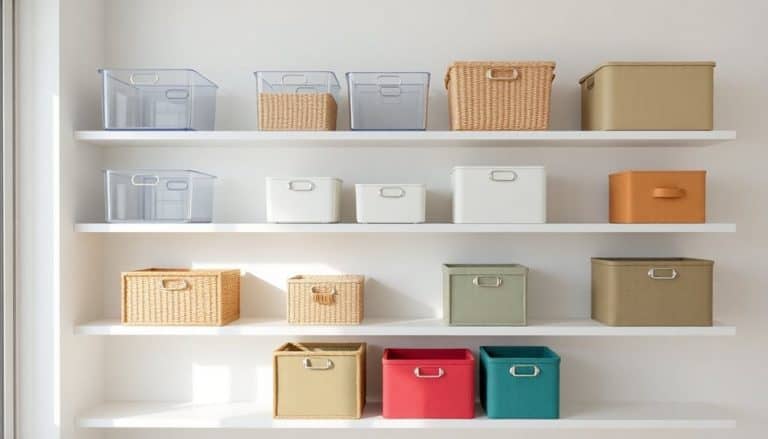This website contains affiliate links. Some products are gifted by the brand to test. As an Amazon Associate, I earn from qualifying purchases. The content on this website was created with the help of AI.
Start with modular packing cubes to organize your travel gear by size and function – use small cubes for accessories, medium for clothing, and large for bulky items. You’ll maximize space by rolling clothes tightly and employing compression bags with one-way air valves. Protect electronics in padded organizers with dedicated compartments, while utilizing waterproof pouches for toiletries and medications. DIY solutions like repurposed pill containers for jewelry and toilet paper rolls for cord management can save money. For valuable items, implement a combination of weatherproof cases and anti-theft measures. There’s much more to discover about efficient travel storage systems.
Key Takeaways
- Use modular packing cubes in different sizes and colors to organize clothes, with compression features to maximize luggage space.
- Employ clear, waterproof containers with secure closures for toiletries and protect against leaks with plastic wrap barriers.
- Store electronics in padded organizers with dedicated compartments, using labeled cable ties and RFID protection for efficient organization.
- Repurpose everyday items like pill containers for jewelry and sunglasses cases for protecting charging cables and small accessories.
- Utilize weatherproof cases with customizable foam inserts for valuable equipment and ensure proper IP67 rating for water protection.
Modular Packing Cubes

Inside your luggage, modular packing cubes create a systematic approach to organizing travel gear. These lightweight mesh or fabric compartments come in various sizes, allowing you to sort clothing and accessories by category, purpose, or destination. You’ll maximize space while maintaining easy access to specific items without disrupting the rest of your packed belongings.
Choose small cubes for socks, underwear, and accessories; medium ones for shirts and pants; and larger cubes for bulky items like sweaters and jackets. Color-coding your cubes helps you quickly identify contents, while compression features let you squeeze out excess air to reduce volume. You can also separate clean clothes from dirty laundry during your trip, maintaining organization throughout your journey.
For ideal efficiency, roll your clothes instead of folding them, and stack the cubes vertically in your suitcase. This method allows you to see all cube contents at once when you open your luggage. Keep frequently needed items in easily accessible cubes near the top, and consider using half-cubes or quarter-cubes for smaller gear like chargers and toiletries.
DIY Storage Solutions
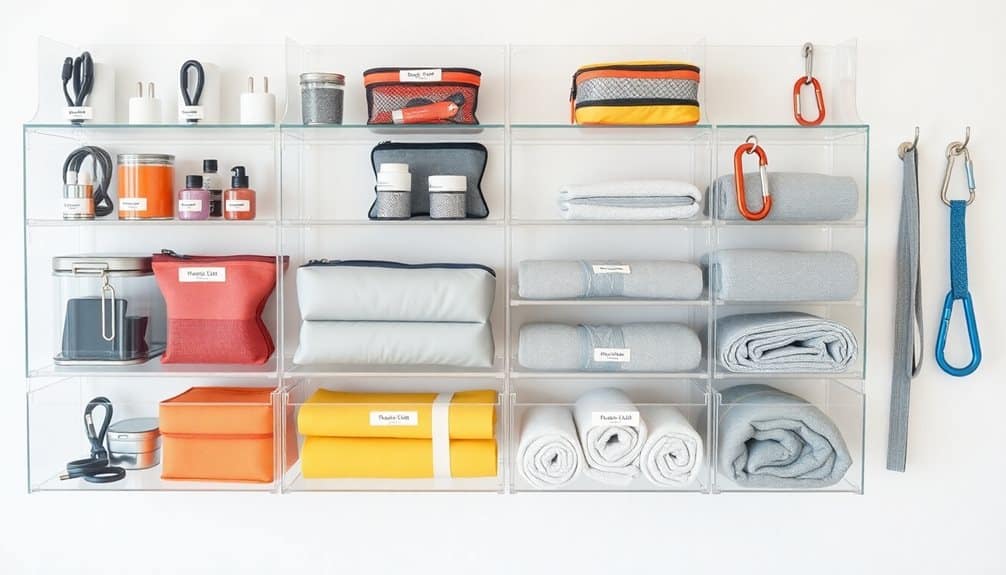
While packing cubes offer excellent organization, clever DIY storage solutions can provide customized alternatives that fit your specific needs and budget. You’ll find that repurposing everyday items can create efficient storage systems that protect your travel gear while maximizing space. Converting old eyeglass cases into electronics organizers or transforming shower caps into shoe covers demonstrates how household items can serve multiple purposes.
Consider these practical DIY storage solutions for your travel gear:
- Transform empty pill containers into jewelry organizers by lining them with felt – perfect for rings, earrings, and small accessories
- Create cord organizers using toilet paper rolls wrapped in decorative paper, securing each cable with rubber bands
- Convert old sunglasses cases into protection for delicate items like charging cables, earbuds, or small camera accessories
- Make waterproof pouches from vinyl shower curtains by cutting and heat-sealing the edges
You can enhance these DIY solutions by adding labels, color coding, or clear windows to identify contents quickly. Remember to test your DIY storage items before your trip to verify they’re durable enough for travel conditions.
Tech Gear Organization

Modern travelers depend heavily on their tech gear, making efficient organization essential for protecting and accessing electronic devices. You’ll want to start with a dedicated electronics organizer featuring padded compartments for your laptop, tablet, and smartphone. Choose one with water-resistant material and elastic straps to prevent devices from shifting during transit.
Organize your cables using small silicone ties or velcro straps, and label each one to avoid confusion. Store these in a compact cable organizer with individual pockets, separating charging cables from data transfer cables. Keep power banks and adapters in a separate mesh compartment to prevent overheating.
For smaller accessories like SD cards, USB drives, and earbuds, use a mini-organizer with clear compartments. Consider investing in a tech pouch with RFID protection for items containing sensitive data. Place frequently used items in easily accessible outer pockets, while keeping backup devices in interior sections.
Don’t forget to include a microfiber cloth for cleaning screens and a small tool kit for emergency repairs. Store all tech gear in your carry-on luggage to maintain control over these valuable items during travel. For optimal device performance, ensure your storage solutions include ventilation holes to prevent overheating of electronics during extended use.
Weatherproof Storage Cases
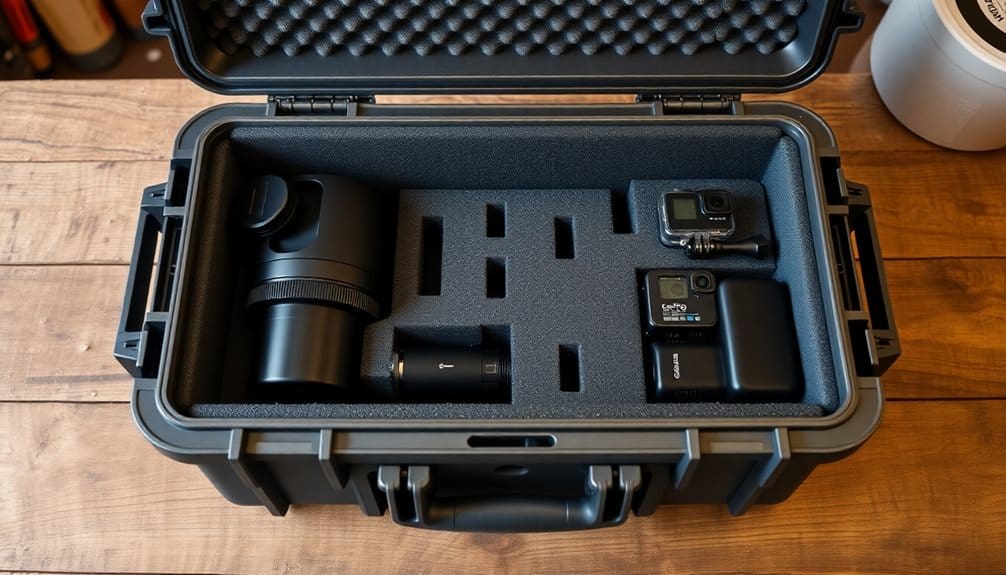
For superior protection against extreme conditions, weatherproof storage cases rank among the most reliable solutions for travel gear. These durable containers feature watertight seals, impact-resistant materials, and pressure equalization valves that prevent moisture damage while protecting your equipment from dust, sand, and shock.
When selecting a weatherproof case, you’ll want to evaluate the IP rating, which indicates the level of protection against water and solid particles. Look for cases rated at least IP67 for complete dust protection and water immersion resistance up to one meter.
- Hard-shell cases with customizable foam inserts let you create perfect-fit compartments for cameras, drones, and sensitive electronics
- Weather-sealed latches and reinforced corners provide additional protection during rough handling or accidental drops
- Clear-lid options allow quick visual inventory without opening the case, saving time during security checks
- Stackable designs with interlocking features maximize storage efficiency in vehicles or equipment rooms
Choose a case size that’s slightly larger than your gear needs to accommodate future additions while maintaining portability. Many professional-grade options include wheels and telescoping handles for easier transport through airports and outdoor terrain.
Space-Saving Compression Techniques
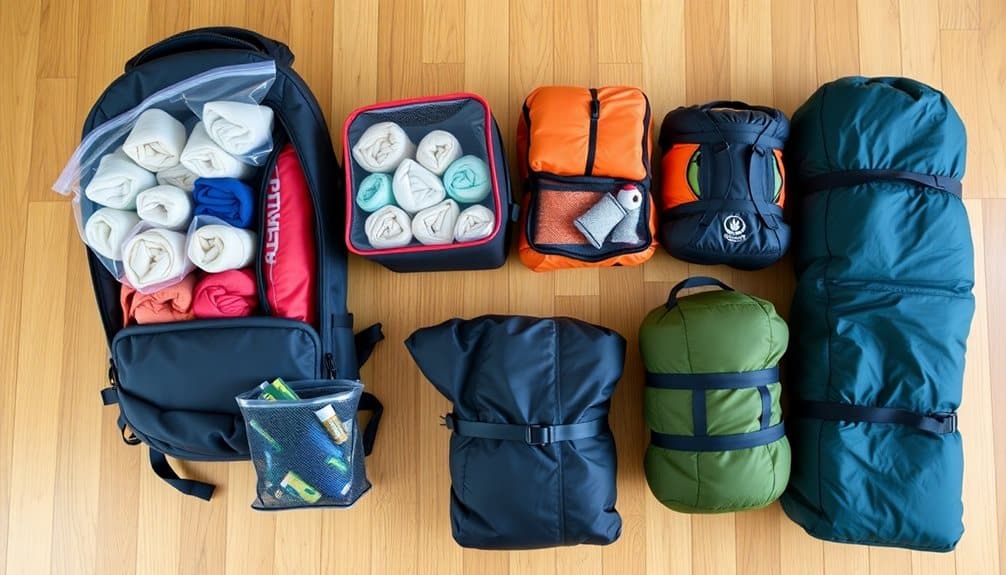
Through the strategic use of compression techniques, you can greatly reduce the volume of your travel gear while maintaining its functionality. Start by rolling your clothes tightly instead of folding them, then secure them with rubber bands or compression straps to prevent unraveling. For maximum efficiency, roll similar items together, such as multiple t-shirts or pairs of socks.
Invest in quality compression bags with one-way air valves that let you squeeze out excess air without it seeping back in. You’ll find these especially useful for bulky items like jackets, sweaters, and sleeping bags. Don’t forget to separate your compressed items into categories using clear bags, which helps maintain organization while maximizing space.
For electronics and cables, wrap cords tightly and secure them with velcro ties or twist ties. Stack similar-sized items together and use cord organizers with multiple compartments. When packing shoes, stuff them with small items like socks or chargers to utilize every inch of space. Remember to compress your gear in a systematic order, placing the most compressed items at the bottom of your bag and working your way up with less compressed ones.
Multi-Purpose Travel Containers
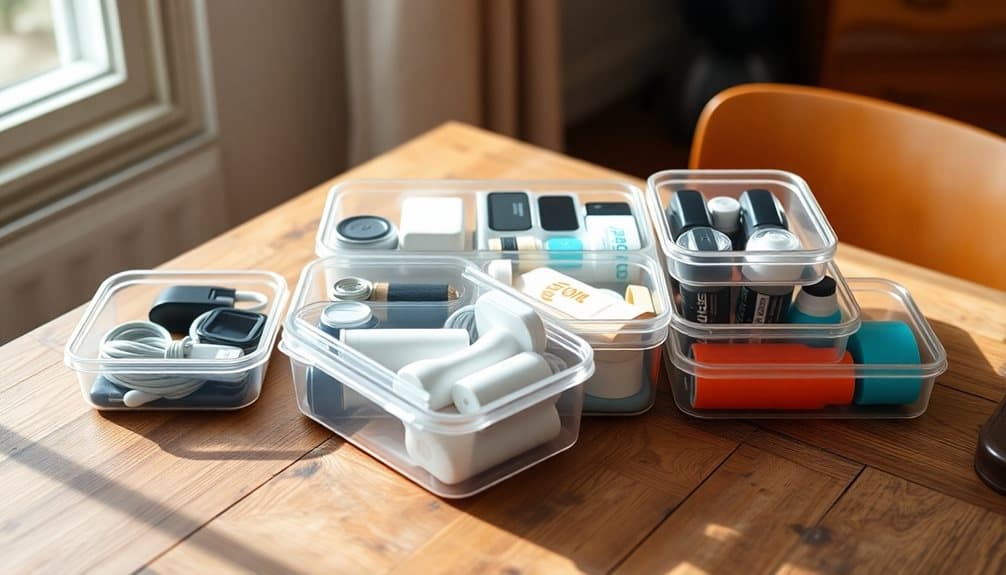
Smart travelers rely on three essential types of multi-purpose containers that maximize storage efficiency while minimizing bulk. You’ll find that silicone compression containers, collapsible fabric organizers, and modular hard-shell cases offer the most versatility for your travel needs. These containers adapt to different purposes, protecting your gear while keeping it readily accessible.
You can transform your travel storage system by implementing these proven container strategies:
- Use food-grade silicone containers for toiletries during travel, then repurpose them for snack storage or impromptu ice packs when needed
- Convert collapsible fabric organizers into temporary laundry hampers, shoe bags, or beach totes by adjusting their configuration
- Employ modular hard-shell cases with removable dividers to protect cameras and electronics, then reconfigure them for souvenir storage
- Stack nested containers to create a mobile office, storing chargers and adapters in the smallest unit, documents in the medium size, and laptop accessories in the largest
When selecting multi-purpose containers, focus on durability, water resistance, and weight. The best options feature reinforced seams, weather-sealed zippers, and lightweight materials that won’t add unnecessary bulk to your luggage.
Camera Equipment Storage
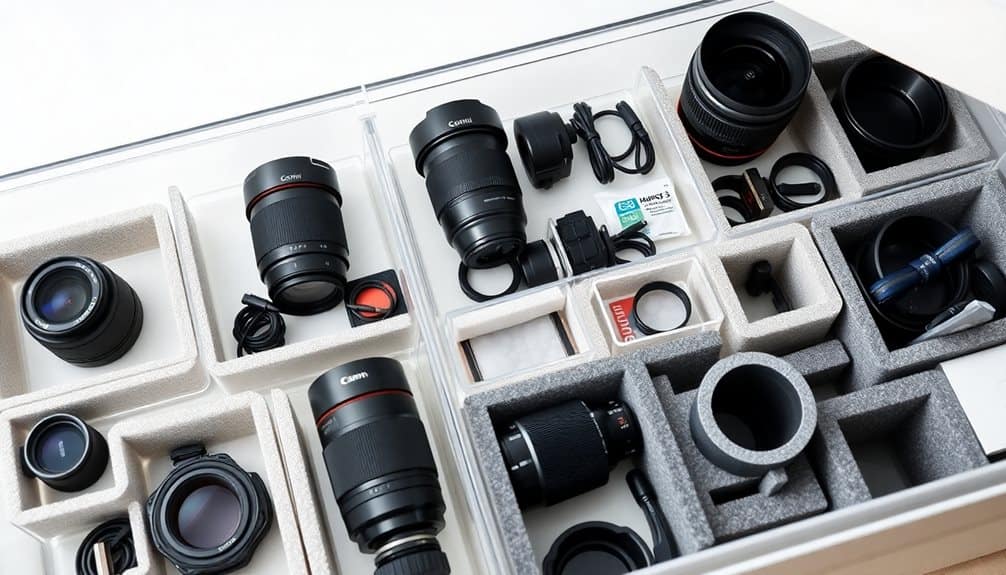
Inside your travel setup, camera equipment demands specialized storage solutions that protect thousands of dollars worth of gear while enabling quick access during shoots. Your primary camera bag should feature customizable padded dividers, allowing you to create snug compartments for each lens, body, and flash unit. Choose a bag with weather-resistant materials and reinforced stitching to guard against moisture and wear.
Organize your gear using a modular system. Place frequently used items like your main camera body and primary lens in easily accessible top compartments. Store backup batteries, memory cards, and cleaning supplies in dedicated side pockets where you’ll consistently find them. You’ll want to use padded lens pouches for additional protection when storing telephoto or specialty lenses.
For compact storage in luggage, remove camera bodies from larger lenses and pack them separately. Use silica gel packets to combat humidity, especially in tropical locations. Consider investing in hard cases with foam inserts for air travel – they’re worth the extra weight for valuable equipment. Label your memory cards and battery sets clearly to track usage and prevent confusion during shoots.
Jewelry and Valuables Protection

When traveling with precious jewelry and small valuables, you’ll need a well-planned system of protective cases and secret compartments to guarantee their safety. The right combination of anti-theft storage solutions will protect your items from both damage and potential theft while keeping them easily accessible.
Choose a dedicated travel jewelry case with individual compartments, padded dividers, and secure closures. You’ll want something compact enough to fit in your carry-on but sturdy enough to prevent crushing. For extra security, invest in a portable travel safe that’s slash-proof and can be secured to fixed objects in your hotel room.
- Store rings and delicate pieces in silicon-lined pouches to prevent scratching
- Thread necklaces through drinking straws to prevent tangling
- Use pill organizers for earrings and small precious items
- Keep a photographic inventory of your valuables on your phone
Don’t forget to diversify your storage locations. Keep high-value items in your hotel safe, but store less valuable pieces in different spots throughout your luggage. If you’re carrying currency or important documents, use a hidden money belt or specialized anti-theft clothing with concealed pockets.
Toiletries and Medication Storage

Much like protecting your valuables, keeping toiletries and medications properly stored during travel prevents messy spills and maintains their effectiveness. Start by investing in TSA-approved clear containers for liquids, and always secure bottle caps with plastic wrap before screwing them shut. Store your toiletries in waterproof bags, keeping similar items together: facial products in one, hair care in another, and dental items in a third.
For medications, you’ll need a system that’s both organized and protective. Use a weekly pill organizer for daily medications, and keep the original bottles with prescriptions in a separate, sealed container. Store temperature-sensitive medications in an insulated pouch, and always pack them in your carry-on luggage. Label everything clearly with contents and dosage instructions.
Create a double-barrier system for liquid toiletries by placing bottles in zip-lock bags, then storing these inside a hard-shell toiletry case. Position toiletries vertically in your luggage to minimize leakage risk, and keep them away from electronics and clothing. Don’t forget to pack a few extra empty bags for wet items during your return journey.
Frequently Asked Questions
How Long Can Travel Gear Be Stored Without Deteriorating?
Did you know that properly stored gear can last up to 15 years longer than improperly stored items? Your travel gear’s lifespan depends on storage conditions and material type. You’ll get 5-7 years from synthetic fabrics, 8-10 years from leather goods, and 10+ years from hard-shell luggage if you store them in a cool, dry place away from direct sunlight and maintain proper cleaning routines before storage.
What’s the Best Room Temperature for Storing Travel Equipment Long-Term?
You’ll want to maintain a consistent temperature between 65-75°F (18-24°C) for ideal long-term storage of travel equipment. Keep humidity levels at 30-50% to prevent mold and material degradation. Don’t store gear in attics or basements where temperatures fluctuate drastically. If you’re using a climate-controlled storage unit, set it to 70°F (21°C) for the best balance of preservation and energy efficiency.
Should Travel Gear Be Insured When Stored at Home?
While your precious travel companions rest peacefully at home, they’re still vulnerable to unexpected surprises. You’ll want to check your homeowner’s or renter’s insurance policy, as standard coverage often isn’t enough for high-value gear. Consider adding a personal articles policy for items like cameras, laptops, and expensive equipment. Document everything with photos and receipts, and maintain an updated inventory list with serial numbers.
How Often Should Stored Travel Gear Be Checked for Damage?
You’ll want to inspect your stored travel gear at least every three months, with more frequent checks during humid seasons. Do a quick monthly scan for moisture, mold, or pest activity. Before and after each trip, conduct thorough examinations of zippers, seams, and straps. If you’re storing electronic travel items, test their functionality every two months and check batteries for corrosion or leakage.
Can Vacuum Storage Affect the Quality of Down-Filled Travel Items?
Yes, vacuum storage can damage your down-filled items since compression disrupts the natural loft of the feathers. You’ll notice reduced insulation and warmth when the down clusters lose their ability to trap air effectively. Instead, store your down sleeping bags, jackets, and pillows loosely in breathable cotton or mesh storage bags. Hang larger items when possible, and avoid plastic containers that can trap moisture and lead to mildew.


